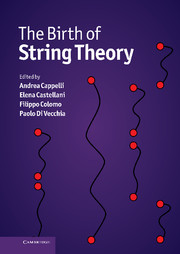Book contents
- Frontmatter
- Contents
- List of contributors
- Photographs of contributors
- Preface
- Abbreviations and acronyms
- Part I Overview
- EARLY STRING THEORY
- Part II The prehistory: the analytic S-matrix
- Part III The Dual Resonance Model
- Part IV The string
- 19 Introduction to Part IV
- 20 From dual models to relativistic strings
- 21 The first string theory: personal recollections
- 22 The string picture of the Veneziano model
- 23 From the S-matrix to string theory
- 24 The analogue model for string amplitudes
- 25 Factorization in dual models and functional integration in string theory
- 26 The hadronic origins of string theory
- TOWARDS MODERN STRING THEORY
- Part V Beyond the bosonic string
- Part VI The superstring
- Part VII Preparing the string renaissance
- Appendix A Theoretical tools of the Sixties
- Appendix B The Veneziano amplitude
- Appendix C From the string action to the Dual Resonance Model
- Appendix D World-sheet and target-space supersymmetry
- Appendix E The field theory limit
- Index
22 - The string picture of the Veneziano model
from Part IV - The string
Published online by Cambridge University Press: 05 May 2012
- Frontmatter
- Contents
- List of contributors
- Photographs of contributors
- Preface
- Abbreviations and acronyms
- Part I Overview
- EARLY STRING THEORY
- Part II The prehistory: the analytic S-matrix
- Part III The Dual Resonance Model
- Part IV The string
- 19 Introduction to Part IV
- 20 From dual models to relativistic strings
- 21 The first string theory: personal recollections
- 22 The string picture of the Veneziano model
- 23 From the S-matrix to string theory
- 24 The analogue model for string amplitudes
- 25 Factorization in dual models and functional integration in string theory
- 26 The hadronic origins of string theory
- TOWARDS MODERN STRING THEORY
- Part V Beyond the bosonic string
- Part VI The superstring
- Part VII Preparing the string renaissance
- Appendix A Theoretical tools of the Sixties
- Appendix B The Veneziano amplitude
- Appendix C From the string action to the Dual Resonance Model
- Appendix D World-sheet and target-space supersymmetry
- Appendix E The field theory limit
- Index
Summary
Abstract
This Chapter is about my memories of the discovery that the Veneziano model in fact describes interacting strings. Susskind and Nambu also found the string picture by following other, independent approaches. A characteristic feature of my approach was that I used very highorder ‘fishnet’ or planar Feynman diagrams to describe the development of the relativistic string. The arrangement of particles on a chain indeed leads to the dominance of planar diagrams, if only nearest neighbour interactions are relevant. I also mention the work of Ziro Koba and myself on extending the Veneziano model, first to five external particles – as also done by Bardakci and Ruegg, Chan and Tsou, and Goebel and Sakita – and subsequently to an arbitrary number of external mesons.
Introduction
In the unpublished preprint [Nie70], ‘An almost physical interpretation of the integrand of the n-point Veneziano model’, I proposed – independently of Nambu [Nam70] and Susskind [Sus70a, Sus70b] – that the dual model or Veneziano model [Ven68] was describing the scattering of relativistic strings.
In the present Chapter I present my recollections on how I came to understand the scattering of strings in the Veneziano model. The background that led to the string idea can be found in the works with Ziro Koba that extended dual models to an arbitrary number of external particles [KN69a, KN69b, KN69c]. This work is described in Section 22.4. It would, however, be natural in such a reminiscence to describe first what for me was crucial, namely the seminar by Hector Rubinstein given at the Niels Bohr Institute.
- Type
- Chapter
- Information
- The Birth of String Theory , pp. 266 - 274Publisher: Cambridge University PressPrint publication year: 2012
- 2
- Cited by



